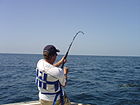Angling
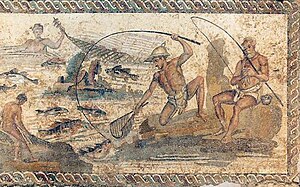

Angling is a method of fishing by means of a fish hook or "angle". The hook is attached to a fishing line, which is usually manipulated via a fishing rod, although rodless techniques such as handlining also exist. Modern fishing rods are usually fitted with a fishing reel that functions as a cranking device for storing, retrieving and releasing out the line, although Tenkara fishing and cane pole fishing are two rod-angling methods that do not use a reel. The hook itself is typically dressed with bait, but sometimes a lure with multiple attached hooks is used in place of a single hook and bait. A bite indicator, such as a float and a weighted sinker, are sometimes used to signal that the fish has swallowed the hook, which anchors firmly in the fish mouth to stop it escaping.
Angling is the principal method of sport fishing, but commercial fisheries also use angling methods such as longlining or trolling. Catch and release fishing is increasingly practiced by recreational fishermen. In many parts of the world, size limits apply to certain species, meaning fish below and/or above a certain size must, by law, be released.
The species of fish pursued by anglers vary with geography. Among the many species of saltwater fish that are caught for sport globally are billfish (swordfish, sailfish and marlin), tuna and grouper, while cod and bass are popular targets in Europe. In North America the most popular sporting freshwater fish species include bass, pike/muskellunge, walleye, yellow perch, trout, salmon, tilapia, and panfishes such as crappie, bluegill and sunfish. In Europe, many anglers fish for species such as carp, pike, bream, tench, rudd, roach, European perch, catfish and barbel.
Hooks[]
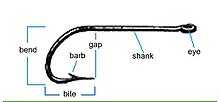
The use of the hook in angling is descended, historically, from what would today be called a "gorge." The word "gorge", in this context, comes from the French word meaning "throat." Gorges were used by ancient peoples to capture fish and animals like seal, walrus and birds. A gorge was a long, thin piece of bone or stone attached by its midpoint to a thin line. The gorge would be baited so that it would rest parallel to the lay of the line. When the game would swallow the bait, a tug on the line would cause the gorge to orient itself at right angles to the line, thereby sticking in the fish or animal's throat or gullet. Gorges evolved into the modern fishing hook which is a J shaped wire with a loop on one end and a sharp point on the other. Most hooks have a barb near the point to prevent a fish from unhooking itself while being reeled in. Some laws and regulations require hooks to be barbless. This rule is commonly implemented to protect populations of certain species. A barbed hook could kill a fish if it were to penetrate the gills.
Baits[]
Which of the various techniques an angler may choose is dictated mainly by the target species and by its habitat. In angling, two type of baits are used: groundbait, which is thrown separately into the water to serve as an "appetizer" and attract distant fish closer; and hookbait, which is actually attached to the fishing hook to entice the fish into swallowing. In colloquial usage, the word "bait" refers specifically to hookbaits, which can be further separated into two main categories: natural or artificial baits.
Natural baits[]
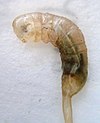
Natural baits are things that are present within the fish's natural diet. The natural bait angler, with few exceptions, will use a common prey species of the target fish as an attractant. The natural bait used may be alive (known as a live bait) or dead, and a bait made of portions of a dead bait are known as a cutbait. Common natural baits for both fresh and saltwater fishing include worms, leeches, minnows, frogs, salamanders, octopus/squid, insects, prawn, crayfish and even crabs. Natural baits are effective due to the real texture, odour and colour of the bait presented.
The common earthworm is a universal live bait for freshwater angling. Grubs and maggots are also excellent bait when trout fishing. Grasshoppers, crickets, bees and even ants are also used as bait for trout in their season, although many anglers believe that trout or salmon roe is superior to any other bait.
Crayfish, which are preyed upon by a variety of ray-finned fishes,[1] are also commonly used as bait, either live or with only the tail meat. They are popular for catching catfish,[2] largemouth bass, smallmouth bass, striped bass,[3] perch and pike.[4] However, studies had confirmed that introducing crayfish outside of their home range has led to various ecological problems of them becoming invasive species.[5][6] Transporting crayfish as live bait has also contributed to the spread of zebra mussels, which are known to attach themselves onto crayfish, in various waterways throughout Europe and North America.[7][8][9]
Artificial baits[]

Artificial baits are baits that are not directly acquired via natural means. These can be edible fish food that are either commercially purchased (e.g. boilies) or prepared food such as cutlets or doughballs made from various mixtures (e.g. rice, semolina, cornmeal, bread, peas and fishmeal, etc.), which can be used to attract omnivorous or herbivorous fish. In lakes in southern climates such as Florida, panfish such as sunfish will even take household bread or pet food as bait. These bread bait is prepared from a small amount of bread, often moistened by saliva, balled up to a small size that is bite size to small fish.
Artificial baits made of inedible materials (e.g. wood, metal, silicone rubber, plastics, etc) are known as lures, which are designed to imitate a live prey (shad, worm, frog, insect, crayfish, etc.) that entice predatory fish to strike. Lures typically do not release any scents and rely solely on looks and sounds/vibrations to attract fish. Some fishing lures may or may not even resemble prey in looks, and may require special movements to impart an enticing presentation to the target fish, for example in fly fishing and topwater fishing. Many anglers prefer to fish solely using lures, as these relies more on the user's rod and reel actions to successfully attract fish and are thus more interactive and exciting. A common way to fish a soft plastic worm is the Texas Rig or the Carolina Rig.
Spreading disease[]

The capture, transportation and culture of bait fish can spread damaging organisms between ecosystems, endangering them. In 2007 several American states enacted regulations designed to slow the spread of fish diseases, including viral hemorrhagic septicemia, by bait fish.[10] Because of the risk of transmitting Myxobolus cerebralis (whirling disease), trout and salmon should not be used as bait.
Anglers may increase the possibility of contamination by emptying bait buckets into fishing venues and collecting or using bait improperly. The transportation of fish from one location to another can break the law and cause the introduction of fish alien to the ecosystem.
Techniques[]
The main rod angling techniques are float fishing, bottom fishing and lure fishing.
Float fishing[]
Float fishing is the most common method of angling, using a fishing line attached with a float (or "bobber" in the United States), which floats at the water surface and suspends the baited hook at a predetermined depth. Due to buoyancy, the float can carry the hook to otherwise inaccessible areas of water by drifting in the prevailing current. When the fish bites and swallows the hook, the float also relay any forces exerted on the hook and serves as a visual bite indicator, as the fisherman can then see it being pulled underwater and/or sideways.
Bottom fishing[]
Bottom fishing, also called legering in the United Kingdom, uses a weighted tackle called a sinker tied to the end of the fishing line to keep the baited hook close to the bottom of the water, in order to target groundfishes such as sucker, bream, catfish and crappie. The sinker can also be used to add momentum to the hook and help casting the line to a further distance. The method can be used both with handlining and rod fishing, and can be done both from boats and from the land. Specialized fishing rods called "donkas" are also commonly used for bottom fishing, and a quiver tip (sometimes coupled with a jingle bell) is used instead as the bite indicator.
Some sinkers are replaced by feeders, which is designed to contain and release groundbaits to help attract fish towards the hook.
Lure fishing[]
Lure fishing uses a type of artificial bait known as lure, which is usually made from inedible materials and does not emit any scent, instead using prey-like appearances, movements, vibrations, bright reflections and flashy colors to attract and entice predatory fish into striking. Many lures are equipped with more than one hooks to better anchor into the fish's mouth, though some hookless lures are used to bait the fish nearer so it can be captured via other means such as spearing, netting/trapping or capturing by hand. In addition to rod angling, handlining, longlining and trolling also employ lure fishing.
When lure fishing recreationally, the fisherman repeatedly casts out the lure afar and then gradually retrieves the line, pulling the lure across the water in the process and creating vibrations, turbulent splashes and/or a popping action, which imitating a small aquatic prey such as a baitfish. A skilled angler can explore many possible hiding places for fish through lure casting such as under logs and on flats. No bite indicator is used, and when the lure catches the attention of a game fish and successfully results in biting/swallowing the lure, the angler can detect it by watching and feeling any vibrations, rod bending and changes in line tension. Lure fishing also typically uses special fishing reels known as spinning reels.
Laws and regulations[]
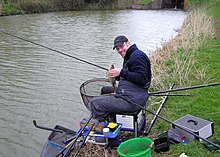
Laws and regulations managing angling vary greatly, often regionally, within countries. These commonly include permits (licences), closed periods (seasons) where specific species are unavailable for harvest, restrictions on gear types, and quotas.
Laws generally prohibit catching fish with hooks other than in the mouth (foul hooking, "snagging" or "jagging"[11]) or the use of nets other than as an aid in landing a captured fish. Some species, such as bait fish, may be taken with nets, and a few for food. Sometimes, (non-sport) fish are considered of lesser value and it may be permissible to take them by methods like snagging, bow and arrow, or spear. None of these techniques fall under the definition of angling since they do not rely upon the use of a hook and line.
Fishing seasons[]
Fishing seasons are set by countries or localities to indicate what kinds of fish may be caught during sport fishing (also known as angling) for a certain period of time. Fishing seasons are enforced to maintain ecological balance and to protect species of fish during their spawning period during which they are easier to catch.
Slot limits[]
Slot limits are put in action to help protect certain fish in given area. They generally require anglers to release captured fish if they fall within a given size range, allowing anglers to keep only smaller or larger fish.[12][13] Slot Limits vary from lake to lake depending on what local officials believe would produce the best outcome for managing fish populations.
Catch and release[]

Although most anglers keep their catch for consumption, catch and release fishing is increasingly practiced, especially by fly anglers. The general principle is that releasing fish allows them to survive, thus avoiding unintended depletion of the population. For species such as marlin, muskellunge, and bass, there is a cultural taboo among anglers against taking them for food. In many parts of the world, size limits apply to certain species, meaning fish below a certain size must, by law, be released. It is generally believed that larger fish have a greater breeding potential. Some fisheries have a slot limit that allows the taking of smaller and larger fish, but requiring that intermediate sized fish be released. It is generally accepted that this management approach will help the fishery create a number of large, trophy-sized fish. In smaller fisheries that are heavily fished, catch and release is the only way to ensure that catchable fish will be available from year to year. The practice of catch and release is criticised by some who consider it unethical to inflict pain upon a fish for purposes of sport. Some of those who object to releasing fish do not object to killing fish for food. Adherents of catch and release dispute this charge, pointing out that fish commonly feed on hard and spiky prey items, and as such can be expected to have tough mouths, and also that some fish will re-take a lure they have just been hooked on, a behaviour that is unlikely if hooking were painful. Opponents of catch and release fishing would find it preferable to ban or to severely restrict angling. On the other hand, proponents state that catch-and-release is necessary for many fisheries to remain sustainable, is a practice that generally has high survival rates, and consider the banning of angling as not reasonable or necessary.[14]
In some jurisdictions, in the Canadian province of Manitoba, for example, catch and release is mandatory for some species such as brook trout. Many of the jurisdictions which mandate the live release of sport fish also require the use of artificial lures and barbless hooks to minimise the chance of injury to fish. Mandatory catch and release also exists in the Republic of Ireland where it was introduced as a conservation measure to prevent the decline of Atlantic salmon stocks on some rivers.[15] In Switzerland, catch and release fishing is considered inhumane and was banned in September 2008.[16]
Barbless hooks, which can be created from a standard hook by removing the barb with pliers or can be bought, are sometimes resisted by anglers because they believe that increased fish escapes. Barbless hooks reduce handling time, thereby increasing survival. Concentrating on keeping the line taut while fighting fish, using recurved point or "triple grip" style hooks on lures, and equipping lures that do not have them with split rings can significantly reduce escapement.
Tournaments and derbies[]

Sometimes considered within the broad category of angling is where contestants compete for prizes based on the total length or weight of a fish, usually of a pre-determined species, caught within a specified time (fishing tournaments). Such contests have evolved from local fishing contests into large competitive circuits, where professional anglers are supported by commercial endorsements. Professional anglers are not engaged in commercial fishing, even though they gain an economic reward. Similar competitive fishing exists at the amateur level with fishing derbies. In general, derbies are distinguished from tournaments; derbies normally require fish to be killed. Tournaments normally deduct points if fish can not be released alive.[citation needed]
Motivation[]
A ten-year-long survey of US fishing club members, completed in 1997, indicated that motivations for recreational angling have shifted from relaxation, an outdoor experience and the experience of the catch, to the importance of family recreation. Anglers with higher family incomes fished more frequently and were less concerned about obtaining fish as food.[17]
A German study indicated that satisfaction derived from angling was not dependent on the actual catch, but depended more on the angler's expectations of the experience.[18]
A 2006 study by the Louisiana Department of Wildlife and Fisheries tracked the motivations of anglers on the Red River. Among the most often stated responses were the fun of catching fish, the experience, to catch a lot of fish or a very large fish, for challenge, and adventure. Use as food was not investigated as a motive.[19]
See also[]
- Bamboo fly rods
- Bibliography of fly fishing
- Gaff
- Piscatorial Society
- Tailrace fishing
- Trolling (fishing)
- Trout worms
References[]
- ^ Web, Animal Diversity (2002-09-16). "Kids' Inquiry of Diverse Species, Orconectes propinquus, northern clearwater crayfish: INFORMATION". BioKIDS. Retrieved 2018-07-27.
- ^ Samsel, Jeff (2005-08-05). "5 Great Catfish Baits". Game & Fish. Retrieved 2021-02-13.
- ^ "Striped Bass Feeding Facts and Information". Bass Fishing Gurus. 2015-03-04. Retrieved 2018-07-27.
- ^ "The Key to Locating Bass, Walleye or Pike". Funny Fishing Tshirts & Fishing Gifts – Fish Face. 2017-08-25. Archived from the original on 27 July 2018. Retrieved 2018-07-27.
- ^ "Fox and Des Plaines Rivers Watershed" (PDF). Critical Trends in Illinois Ecosystems. Illinois Department of Natural Resources. 2001.
- ^ Tennessee Aquatic Nuisance Species Task Force (2007). Tennessee Aquatic Nuisance Species Management Plan (PDF). Tennessee Wildlife Resources Agency.
- ^ "Hawaii Risk Analyses and Management for Dreissenid Mussels" (PDF). US Fish & Wildlife. 2012. p. 3. Retrieved 27 July 2018.
- ^ "zebra mussel (Dreissena polymorpha) – Species Profile". Nonindigenous Aquatic Species. 2005-11-16. Retrieved 2018-07-27.
- ^ J. Thompson; F. Parchaso; A. Alpine; J. Cloern; B. Cole; O. Mace; J. Edmunds; J. Baylosis; S. Luoma; F. Nichols (13 December 2007). "The History and Effects of Exotic Species in San Francisco Bay". United States Geological Survey.
- ^ DNR Fishing Regulation Changes Reflect Disease Management Concerns with VHS Archived 2008-12-14 at the Wayback Machine
- ^ Illegal fishing methods NSW Government Industry and Investment. Retrieved 8 January 2010.
- ^ "Fishing limits – What is a slot limit?". Florida Fish and Wildlife Conservation Commission. Archived from the original on 8 December 2012. Retrieved 20 October 2011.
- ^ "What are slot limits?". Kansas Department of Wildlife, Parks and Tourism. Retrieved 20 October 2011.
- ^ Understanding the Complexity of Catch and Release in Recreational Fishing: An Integrative Synthesis of Global Knowledge from Historical, Ethical, Social, and Biological Perspectives Published in Reviews in Fisheries Science, Volume 15, Issue 1 & 2 January 2007, pages 75 – 167 Authors: Robert Arlinghaus; Steven J. Cooke; Jon Lyman; David Policansky; Alexander Schwab; Cory Suski; Stephen G. Sutton; Eva B. Thorstad
- ^ Fishing in Ireland Catch and Release for Atlantic Salmon
- ^ Animal Rights Law Passed in Switzerland – Catch and Release Fishing Banned
- ^ Schramm, H. L.; Gerard, P. D. (2004). "Temporal changes in fishing motivation among fishing club anglers in the United States – Abstract". Fisheries Management and Ecology. 11 (5): 313. doi:10.1111/j.1365-2400.2004.00384.x. Archived from the original on 2013-01-05. Retrieved 2009-05-06.
- ^ Arlinghaus, Robert (2006). "On the apparently striking disconnect between motivation and satisfaction in recreational fishing : the case of catch orientation of german anglers". North American Journal of Fisheries Management. 26 (3): 592–605. doi:10.1577/M04-220.1. Retrieved 2009-05-06.
- ^ Yeong Nain Chi Socioeconomic Research and Development Section Louisiana Department of Wildlife and Fisheries. "Segmenting Fishing Markets Using Motivations" (PDF). e-Review of Tourism Research (eRTR), Vol. 4, No.3, 2006. Archived from the original (PDF) on 2011-07-06. Retrieved 2009-05-06.
External links[]
| Wikimedia Commons has media related to Angling. |
| Wikisource has original works on the topic: Angling |
| Wikibooks has a book on the topic of: River Fishing |
- Project Gutenberg: The Compleat Angler
- How to fish taken from the Boy's Own Book of Outdoor Sports (early 1900s)
- Angling
- Recreational fishing
